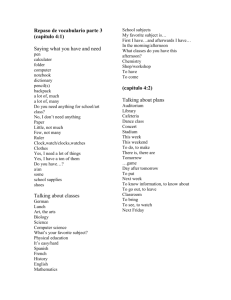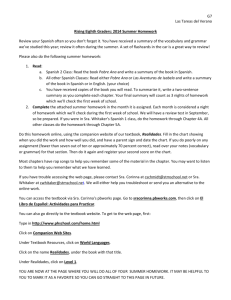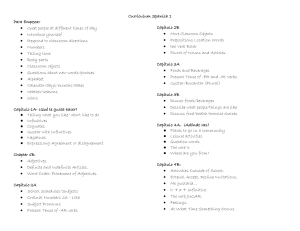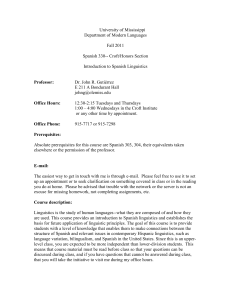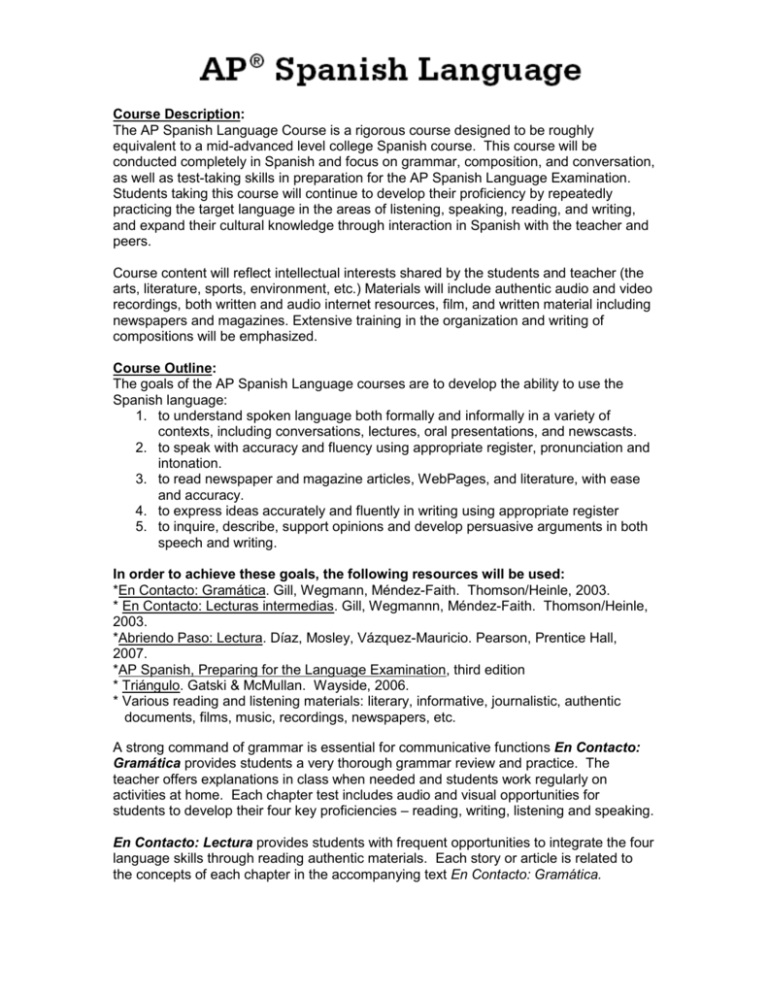
Course Description:
The AP Spanish Language Course is a rigorous course designed to be roughly
equivalent to a mid-advanced level college Spanish course. This course will be
conducted completely in Spanish and focus on grammar, composition, and conversation,
as well as test-taking skills in preparation for the AP Spanish Language Examination.
Students taking this course will continue to develop their proficiency by repeatedly
practicing the target language in the areas of listening, speaking, reading, and writing,
and expand their cultural knowledge through interaction in Spanish with the teacher and
peers.
Course content will reflect intellectual interests shared by the students and teacher (the
arts, literature, sports, environment, etc.) Materials will include authentic audio and video
recordings, both written and audio internet resources, film, and written material including
newspapers and magazines. Extensive training in the organization and writing of
compositions will be emphasized.
Course Outline:
The goals of the AP Spanish Language courses are to develop the ability to use the
Spanish language:
1. to understand spoken language both formally and informally in a variety of
contexts, including conversations, lectures, oral presentations, and newscasts.
2. to speak with accuracy and fluency using appropriate register, pronunciation and
intonation.
3. to read newspaper and magazine articles, WebPages, and literature, with ease
and accuracy.
4. to express ideas accurately and fluently in writing using appropriate register
5. to inquire, describe, support opinions and develop persuasive arguments in both
speech and writing.
In order to achieve these goals, the following resources will be used:
*En Contacto: Gramática. Gill, Wegmann, Méndez-Faith. Thomson/Heinle, 2003.
* En Contacto: Lecturas intermedias. Gill, Wegmannn, Méndez-Faith. Thomson/Heinle,
2003.
*Abriendo Paso: Lectura. Díaz, Mosley, Vázquez-Mauricio. Pearson, Prentice Hall,
2007.
*AP Spanish, Preparing for the Language Examination, third edition
* Triángulo. Gatski & McMullan. Wayside, 2006.
* Various reading and listening materials: literary, informative, journalistic, authentic
documents, films, music, recordings, newspapers, etc.
A strong command of grammar is essential for communicative functions En Contacto:
Gramática provides students a very thorough grammar review and practice. The
teacher offers explanations in class when needed and students work regularly on
activities at home. Each chapter test includes audio and visual opportunities for
students to develop their four key proficiencies – reading, writing, listening and speaking.
En Contacto: Lectura provides students with frequent opportunities to integrate the four
language skills through reading authentic materials. Each story or article is related to
the concepts of each chapter in the accompanying text En Contacto: Gramática.
Abriendo Paso: Lectura provides students with opportunities to integrate the four
language skills through reading authentic stories by renowned authors.
Triángulo provides thematic practice of language skills with extensive vocabulary
building, listening and reading comprehension exercises. It also provides for practice
with both the informal and formal speaking and writing tasks in the format of the AP
Spanish Language examination. Being thematic in nature, it allows students to practice
these skills while developing some familiarity with the appropriate vocabulary.
AP Spanish, Preparing for the Language Exam is an essential supplement that
provides extensive vocabulary and grammar practice similar to the actual format of the
AP Spanish Language exam. This text is used to extend knowledge of not only the test
itself, but of vocabulary and reading comprehension. This text provides frequent
opportunities to write a variety of compositions in Spanish. In addition the text provides
a variety of listening comprehension exercises.
Course Instructional Plan:
Fall Semester
Unit
Unit 1
Unit 2
Unit 3
Chapters from
Triángulo
Capítulo 6: Los deportes
actividades, ejercicio,
equipo, lugares
Chapters from
En contacto
Capítulo 1: Diversiones y
fiestas
Capítulo 9: El prójimo
características físicas,
emociones, familia,
personalidad
Capítulo 2: Vejez y juventud
Capítulo 1: El hogar
aparatos, comida,
herramientas, muebles
Capítulo 3: La presencia
latina
Unit 4
Present tense, personal a,
nouns/articles, reflexives
Preterite tense, irregular verbs in
preterite tense, Imperfect tense,
Choosing between preterite and
imperfect, Hace+time expressions
Adjectives, Ser vs Estar, Future
and Conditional tenses, Present
Subjunctive tense, Use of the
Subjunctive
Capítulo 4: Hombres y
mujeres
Subjunctive vs the indicative,
adjectives and noun clauses in the
subjunctive, adverbial clauses in
the subjunctive
Unit 5
Unit 6
Capítulo 7: La educación
actividades, estudios,
muebles, personas
Capítulo 5: Vivir y aprender
Capítulo 4: El turismo
aeropuerto, caminos,
culturas extranjeras,
medios de transporte
Capítulo 6: De viaje
All perfect tenses including future
and conditional perfect,
sequencing.
Present and Pluperfect
Subjunctive, If clauses,
sequencing
Literary Selection
Abriendo paso: Lectura
“El décimo” by Emilio
Pardo Bazán
“La fiesta de San
Fermín”
“Nosotros, no” por José
Bernardo Adolph
“El árbol de oro” by Ana
María Matute
“La Tomatina”
“Cartas de amor
traicionado” by Isabel
Allende
“Cajas de cartón” by
Francisco Jiménez
“El delantal blanco” by
Sergio Vodanovic
Spring Semester
Unit
Unit 7
Chapters from
Triángulo
Capítulo 2: La salud
accidentes, cuerpo,
emergencias, medicina,
médicos
Unit 8
Chapters from
En contacto
Capítulo 7: Gustos y
preferencias
Verbs like gustar,
affirmative/negative words,
demonstrative adjectives,
possessives
Capítulo 8: Dimensiones
culturales
Reflexives vs non reflexives,
reflexives with commands,
reciprocal reflexives, impersonal
se, passive se, comparatives and
superlatives
Unit 9
Unit
10
Unit
11
Unit
12
Literary Selection
Abriendo paso: Lectura
“Emma Zunz” por Jorge
Luis Borges
Capítulo 3: El medio
ambiente
al aire libre, animales,
tiempo, topografía
Capítulo 9: Un planeta para
todos
Capítulo 8: El comercio
finanzas, profesiones,
tiendas, trabajo
Capítulo 10: La imagen y los
negocios
Capítulo 10: De todo un
poco
avances tecnológicos,
derecho, futuro, policía,
política
Capítulo 11: ¡Adiós,
distancias!
Capítulo 5: El ocio
arte, ciencia ficción,
espectáculos, fiestas,
sueños, teléfono,
televisión
Capítulo 12: La imaginación
creadora
“No oyes ladrar los
perros” by Juan Rulfo
“Los indios kunas”
“Un oso y un amor” by
Sabine Reyes Ulibarrí
Lo + adjective, adverbs, use of the
infinitive, gerunds and the verb
acabar de
Past participle as adjective, passive
voice, commands (including
vosotros), commands with
pronouns, review of direct and
indirect object pronouns,
sequencing
Por vs para, relative pronouns,
diminutives, review of ser vs estar
and
preterite vs imperfect, sequencing
“Jacinto Conteras
recibe su paga
extraordinaria” by
Camilo José Arreorola
“Jaque mate en dos
jugadas” by Isaac
Aisemberg
“Fernando Botero, El
espejo convexo”
Review and practice for AP exam
Student Evaluation:
Each unit contains a series of quizzes, tests, debates, essay, readings, presentations,
writing activities, speaking activities and a project related to the theme of the chapter.
1. The focus of the class is to encourage students to speak exclusively in Spanish.
Daily formative speaking assessments reflect the exclusive use of the Spanish language
and are evaluated informally in class and formally using language lab.
Informal speaking takes place in class by means of debates, presentations,
conversations and discussions. The informal speaking is evaluated by teacher
using multiple avenues including but not limited to observation and participation.
Formal speaking based on varying types of topics and processes are evaluated
by teacher using the language lab. Student speaking task is recorded and
fluency, content and interpersonal proficiency is assessed. Many of the formal
speaking assessments are given using the format of the AP exam.
Since the focus of the class is encouraging students to speak exclusively in Spanish, the
informal and formal assessments are wonderful tools for evaluation and enrichment.
2. Formative writing assessments are given weekly in the forms of emails, journal
writing, letters and persuasive essays. These assignments are given to assess fluidity of
writing, rich vocabulary, and control of syntax and expression. The writings are
evaluated and given back to the student for revision. Formative writings will also include
tasks to is a great tool with which to learn how to synthesize information given by an
outside source and use that information to create a clear, organized essay that
demonstrates excellence in syntax and expression.
3. Quizzes assess the ongoing development and acquisition of vocabulary and also
provide a way to measure mastery of various grammatical structures. Quizzes may also
include short evaluations, multiple choice and short answer regarding reading selections
and other course content. These assessments are administered to reflect a mastery of
vocabulary and grammatical structures needed to succeed on the AP exam.
4. Essays and readings are assessments directly related to the format of the AP exam.
Weekly, topics are given to the students upon which to reflect and write a well organized
essay. The topics are taken from the chapter theme or the AP preparation book that
accompanies the main text.
5. Exams contain a variety of components, including reading, writing, listening, literature
and culture. These assessments contain both free-response and fill in the blanks
questions about readings, presentations, grammar, and vocabulary. Students are
required to make comparisons and synthesize information learned in class. Speaking is
also assessed in class before the exam using the language lab and is graded according
to the rubrics outlined for the AP Spanish Language 2007 Released Exam. Formal
writing is assessed separately as well and converted to a percentage of the overall
average. Each concept is practiced and evaluated weekly.
6. Projects are assigned per chapter and are based on the theme of the chapter.
Projects vary yet always include speaking and writing components both formal and
informal that allocate opportunities for student creativity and written as well as
presentational practice in the native language.
Listening Comprehension Skills
Audio sources are selected from the internet, the textbooks and supplemental materials
for the course. Goals will differ depending on audio source but the main focus will be to
listen for controlled information and synthesize that information to complete questions or
extract details with which to compile in written format.
Some examples of what a student will do are as follows. The student will:
a. Listen to a ten minute lecture in Spanish and respond correctly to oral/written
questions on the material.
b. Comprehend oral questions and respond appropriately and quickly.
c. Summarize orally or in writing after viewing a Spanish language film.
d. Summarize orally or in writing the key points of a lecture given in Spanish.
e. Respond appropriately to questions based on a brief oral narrative.
f. Respond spontaneously to a variety of questions posed in class.
g. Watch the Spanish channel and summarize what was seen in either written
or spoken format.
Sources: Texts:
En Contacto,
Triángulo
AP Spanish: A Guide to the Language Course
Abriendo Paso: Lectura
Spanish channel accessible through county
Song lyrics
Speaking Skills
Students are challenged daily to respond to conversational props in venues such as
interviews, advice, storytelling, speeches and interpersonal scenarios. Using both
observation and the language lab, students are recorded and evaluated according to
their grammatical accuracy, richness of vocabulary, fluency, idiomatic usage and syntax.
Students are also regularly called upon to give oral presentations.
The student will:
a. Speak extemporaneously on a given topic using appropriate vocabulary
and accurate grammar.
b. Both initiate and participate in conversations on everyday topics.
c. Improvise orally, based on a series of cues.
d. Make an oral presentation on a prepared topic using notes
e. Paraphrase/summarize a reading passage.
f. Discuss in Spanish materials read and heard in class.
g. Participate in a discussion based on an oral presentation.
Sources:
AP Spanish: A Guide to the Language Course
Triángulo
Extemporaneous topics selected by teacher
Reading Skills
Students are exposed weekly to the world of Spanish literature and idioms through
current events as outlined on news sites on Internet, magazines and newspapers.
Furthermore, students are required to read a story from the accompanying text Abriendo
Paso – Lectura each chapter. These selections are authentic and reflect famous
authors from varying countries. Students are required to read texts and give oral and/or
written summaries of the information.
The student will:
a. develop a familiarity with vocabulary for literary analysis
b. compare and contrast themes
c. write critically about literature beyond plot and summary
d. gain confidence in their ability to read in a second language and improve their
linguistic skills
e. read a variety of articles on a wide variety of topics
Sources:
Abriendo Paso: Lectura
En contacto: Lectura
Internet Sources for Hispanic Periodicals and WebSites
Writing Skills
Every week students write an informal essay in a journal entry. These entries are based
on topics provided by the teacher and are thematic in nature. Journal entries may be
free choice or creative writing in nature based on the information discussed in class or
viewed/read from an outside source.
In each unit, students write a formal, well-organized essay of at least 200 words on a
topic designated by the teacher. Each formal writing is assessed using the AP rubric
and evaluated for its content, organization, rich vocabulary, grammatical accuracy, and
synthesis of the provided sources.
During the first semester, students will practice using written sources. They will be
asked to identify and underline two or three main points or supporting details. They will
then paraphrase in writing those details. In small groups, students will compare
summaries to assess their comprehension of the text. They will perform a similar
exercise using audio sources. Students will paraphrase two or three main points from
an audio selection and compare their summaries in small groups.
The student will:
a. identify main points as well as concrete details of authentic texts and express
them in written format
b. be able to paraphrase details of the story
c. demonstrate comprehension by synthesizing audio and textual input to write
a well organized essay outlining the key concepts
Sources:
Abriendo Paso; Lectura
Triángulo
AP Spanish: A Guide to the Language Course
Internet Resources:
To provide reinforcement and enrichment activities related to grammar, vocabulary and
projects throughout the year, the internet is utilized as a source for this AP course. The
sites listed below are examples of sites used in this AP course to provide authentic realtime cultural information and access to current events.
AP tests are all inclusive which means that the AP course must also be all inclusive.
The information needed to effectively teach this course is not only found in the multiple
texts listed on the syllabus but also the Internet – a gateway to the Latino world.
News/ Reading Sources:
http://www.cnn.com/espanol/
http://www.abc.es/
http://www.caretas.com.pe/Main.asp
http://www.elsalvador.com/
http://www.elmercurio.com
http://www.elpais.com
http://www.eluniversal.com.mx
www.nacion.com
www.prensaescrita.com
www.bbcmundo.com
Sources for Listening Activities:
www.un.org/radio/es
www.bbcmundo.com
www.cnn.com/espanol/

